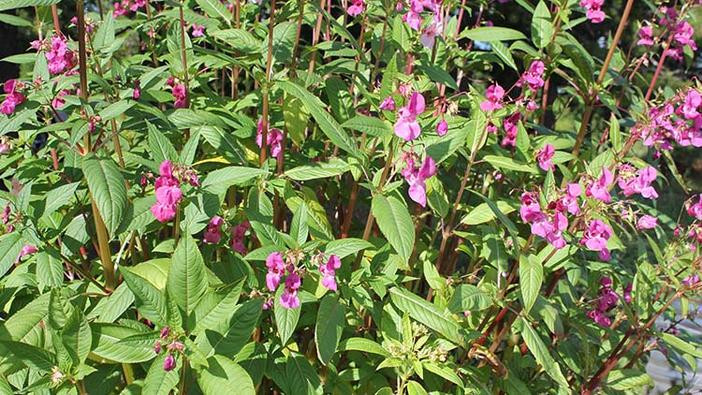Place of origin
Native to India, Himalayan balsam (Impatiens glandulifera) was likely introduced to North America as an ornamental plant. Himalayan balsam has been found in Alberta along water bodies.
Habitat
Grows in moist, nutrient rich soil and thrives in disturbed riparian habitats and wet woodlands.
Identification
Use keyboard or mouse to scroll through the gallery
- Himalayan balsam leaves are simple, oblong-shaped with serrated edges, arranged oppositely on a square, hollow stem.
- Leaf veins and stems have red to purple tinges. Flowers are irregular with 5 purple to pink to white petals and resemble an English policeman's helmet.
- Round brown seeds are released explosively when a ripened capsule is disturbed or dried.
Reproduction
Himalayan balsam is only able to reproduce by seed; however, a single plant can produce up to 4,000 seeds that launch up to 10 m in all directions.
Issues
- Displaces native vegetation, reducing habitat for wildlife and native plants.
- Draws pollinators away from native plants.
Current management in Alberta
Control of Himalayan balsam can be difficult, especially once well established. Methods for control or eradication by trained personnel include:
- careful hand digging for isolated or small populations
- repeated mechanical cutting
- chemical treatment
The objective for control is to repeatedly remove the plants before they set seed.
Resources
Help stop the spread of invasive plants
Report aquatic invasive species:
- Phone: 1-855-336-2628 (BOAT)
- Online: EDDMapS
Learn more about identifying and preventing invasive aquatic plants:
- List of prohibited species
- Aquatic Invasive Species Pocket Guide
- ALMS Field Guide to Aquatic Plants
- Invasive Plants (Alberta Invasive Species Council)
Spread the word about the threats invasive plants pose:




